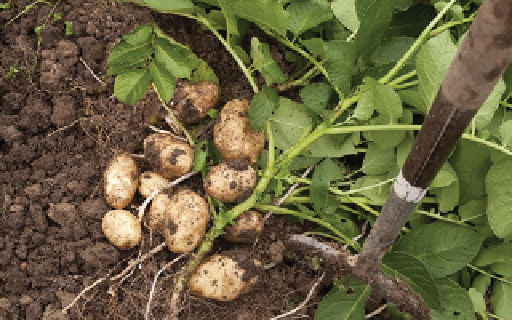Agriculture Reference
In-Depth Information
Potatoes like well-manured soils, though the manure should be applied the previous autumn. At the
same time, one of the potato's great strengths is that it also grows in meager soils.
Plant potatoes out in mid to late spring. If you are unsure about the best planting date in your area,
ask area farmers and gardeners. Planting distances: 20-28 in. (50-70 cm) rows, 12 in. (30 cm) apart
within the row. Plant potatoes 3-4 in. (8-10 cm) deep. Plant into hilled rows: hill soil up about 8 in.
(20 cm) high with a plow or hoe, so the soil can warm up faster and to improve drainage. Plant tubers
with sprouts facing up in small holes made in the hilled rows. When above-ground foliage has grown
to about 8 in. (20 cm) high, hill up soil again. This helps increase yield, as new tubers are formed by
shoots covered with soil.
Cultivate potatoes as early in the year as possible to help avoid aphid attacks and viral infections.
Viruses cause tubers to get smaller from year to year, which reduces overall yield. Viruses are spread
by aphids. When the first generation of aphids appears and one aphid infects one potato, it takes three
weeks for the virus to travel from leaf to tuber. The virus is then planted out again the following year
unless new virus-free seed potatoes are acquired. For these reasons, we recommend the following two-
step preventative measure during cultivation:
'Arran Pilot' is a favorite heirloom potato in the United Kingdom, prized by gardeners for its taste, scorned by commercial
growers for its lack of uniformity.
COURTESY ISTOCKPHOTO/ZANDEBASENJIS
1. Set out insect monitor cards
. Start checking regularly in early summer to see if any aphids are stuck
to the cards. Three weeks after the first aphid is found, it's time for step 2:
2. Pull up the green, above-ground shoots of potato plants
. Simply rip out the entire above-ground por-
tion of the plant. It may be easiest to stand directly on the hill plants are growing in, to hold tubers un-
derground with your feet while you pull the bushes out. The tubers of these plants will be smaller, but
they will have ideally been kept virus-free and can be used as seed potatoes the next year. Allow tubers
to ripen in the ground for two weeks, so their skin can harden. Do not cut stems! The resultant wound
would be an ideal place for aphids to suck the juices of the potato plant.

